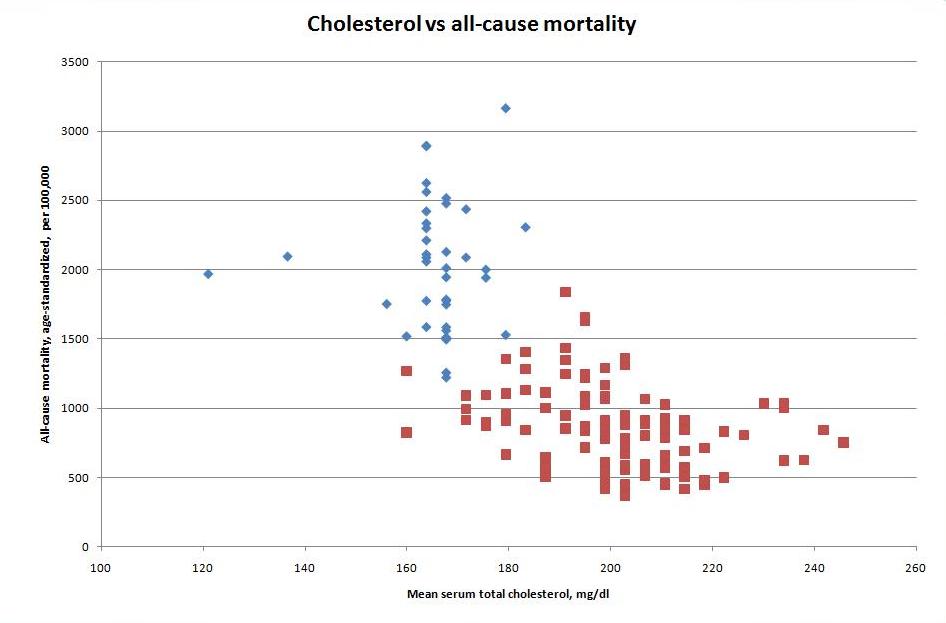We’re in the midst of a little diversion looking at the cholesterol levels of hunter-gatherers around the world. This investigation was precipitated by the surprising claim by some Paleo authorities that hunter-gatherers had much lower cholesterol levels than any modern human population (Did Hunter-Gatherers Have Low Serum Cholesterol?, Jun 28, 2011).
We started by looking at Eskimos and Inuit (Serum Cholesterol Among the Eskimos and Inuit, July 1, 2011). We found that healthy Eskimo and Inuit groups seem to consistently have mean serum cholesterol between 200 and 230 mg/dl, with lower mean serum cholesterol levels found only in short-lived populations suffering from tuberculosis and parasite infections.
Today we’ll look at the populations with the lowest reported serum cholesterol levels: African hunter-gatherers. Africans made up 3 of the 5 groups claimed to have low serum cholesterol in the original Eaton et al paper [1] and 4 of the 5 in the later Cordain et al paper [2].
Cholesterol levels in modern Africans
Before looking at African hunter-gatherers, I think it’s worthwhile to look at modern Africans and African-Americans.
African nations have the lowest serum cholesterol levels and highest mortality levels in the world:
- The 39 sub-Saharan African countries in O Primitivo’s cholesterol database have an average serum total cholesterol (TC) of 165.7 mg/dl (4.285 mmol/l). For comparison, the other 122 nations have an average serum TC of 201.1 mg/dl (5.20 mmol/l).
- When the 161 countries in the database are ranked by mortality, sub-Saharan African nations occupy all but three of places 123 through 161. The non-African nations with highest mortality are Laos (#130), Cambodia (#131), and Haiti (#137). Haiti’s population is 95% of African descent, by far the largest African population share in the Americas. The only sub-Saharan African nations ranking above #123 are the island nations of Cape Verde, Comoros, and Sao Tome and Principe.
Here are the nations in O Primitivo’s database. Sub-Saharan African countries are in blue, others in red:
Sub-Saharan African TCs cluster around 165 mg/dl, while in the rest of the world varies much more widely but generally ranges between 170 and 240 mg/dl. The only countries outside sub-Saharan Africa with a mean TC below 170 mg/dl are Bangladesh and Tunisia.
Now, African-Americans. Here are mean serum cholesterol levels from the various NHANES studies:
Mean serum cholesterol levels (mg/dl) in Americans age 20-74 from NHANES
| Group | 1960-1962 | 1971-1974 | 1976-1980 | 1988-1994 | 1999-2000 |
| All | 222 | 216 | 215 | 205 | 204 |
| Whites | 222 | 216.5 | 214.5 | 205 | 205 |
| Blacks | 215.5 | 216.5 | 213 | 202.5 | 195.5 |
| Hispanics | — | — | 209 | 205 | 202.5 |
This table makes visibly clear the triumph of modern medicine: mean serum cholesterol levels have been heroically brought down from 222 mg/dl in 1960 to 204 mg/dl today.
This data is useful, because African-Americans eat a diet similar to that of other Americans. They are also, by global standards, fairly healthy. All-cause mortality in 2005-7 in Contra Costa, California (a quick search failed to bring up numbers for the US as a whole) was 683.9 per 100,000 for whites and 1002.7 for blacks (Source).
If we look above at O Primitivo’s data, a mortality of 1002.7 is lower than that of any sub-Saharan African nation and would suggest a TC around 195 mg/dl – right where African-Americans are today. White mortality of 683.9 would suggest a mean TC between 200 and 220 – right where white Americans are.
To me, this data suggests:
- If there is a genetic difference in Africans that lowers cholesterol, it’s not large – probably less than 10 mg/dl.
- Africans fit spot-on the cholesterol vs mortality curve established by non-African nations. So if there are genetic differences in Africans, they haven’t altered the mortality risk of low cholesterol levels.
- In any ethnicity or race, low serum cholesterol indicates impaired health – probably due to infections – and higher mortality.
In interpreting the serum cholesterol of African hunter-gatherers, we should keep in mind this pattern. Low TC is probably only minimally a matter of genetics or diet. It’s primarily about infectious burden.
Now let’s look at African hunter-gatherer populations. Unfortunately, there is a paucity of data in Pubmed.
Hadza
A search in Pubmed for “Hadza cholesterol” produces one paper [4]. Unfortunately it dates from 1972 and electronic availability for that journal begins in 2001, so I was unable to read it.
Congo Pygmies
There are no papers in Pubmed searches for “pygmy cholesterol” or “pygmies cholesterol,” nor does “Congo cholesterol” return anything resembling a hunter-gatherer cholesterol study.
According to Wikipedia (“Pygmy peoples”), “The best known pygmies are the Aka, Efé and Mbuti of central Africa.” However, “Aka cholesterol,” “Efé cholesterol,” and “Mbuti cholesterol” return no results either.
!Kung San, Khoisan, Kalahari San, Bushmen
These people may be referred to by a variety of names, as Wikipedia (“Bushmen”) notes:
The indigenous people of southern Africa … are variously referred to as Bushmen, San, Sho, Barwa, Kung, or Khwe. These people were traditionally hunter-gatherers, part of the Khoisan group …
Searching on all these terms, I was able to find only a few reports on cholesterol levels, not all of whom were eating the hunter-gatherer diet. Here’s a summary.
Cholesterol Levels of San Bushmen
| Paper [ref] | Mean TC | Notes |
| Miller et al 1968 [23] | 77 mg/dl | Stale samples, poorly preserved samples, “difficult” technique not normally used for cholesterol measurement |
| Truswell & Hansen 1968 [24] | 110 mg/dl | Stale unfrozen samples, obsolete technique |
| Bersohn & Tobias 1966 | 123 mg/dl | Unknown technique; reported by Truswell & Hansen [24]; farm bushmen were 145 mg/dl. |
| Tichelaar et al 1992 [26] | 143 mg/dl | Semi-settled |
| van der Westhuyzen J et al. [21] | 158 mg/dl | Semi-settled |
Early reports showed the lowest TCs. The one from Klara Miller and colleagues in the Archives of Internal Medicine of 1968 [23], is not available to me as full text, but this is the abstract:
Samples of the plasma from nine male adult bushmen were analyzed for their lipid content. The mean results obtained (total cholesterol = 77 mg/100 ml, phospholipids = 107 mg/100 ml, and triglycerides= 49 mg/100 ml) were extremely low. The probable reasons for this finding are the very low dietary fat content and habitually high physical activity of Kalahari bushmen. [23]
These numbers are extraordinarily low for both TC and serum phospholipids.
My other early source was a 1968 letter to Lancet by Truswell and Hansen [24] commenting on the Miller et al report:
SIR,-We can add some more data to the values for serum lipids in 9 Kalahari bushmen which you reviewed in your annotation (Aug. 17, p. 395). Our findings confirm that these hunter-gatherers have among the lowest serum-cholesterol levels in the world.
In October, 1967, and again in April-May this year we joined the Harvard social anthropologists De Vore and Lee to investigate the medical and nutritional state of the !Kung bushmen they have been studying in the northern Kalahari, Botswana. We collected venous blood from some of these bushmen. Sera were allowed to separate by clot-retraction and decanted into tubes containing a little dried methiolate solution. The sealed serum-tubes were kept in a portable gas refrigerator while we were in the desert and were carried with us in a cool box, with ice-packs, when we travelled back to Cape Town by jeep and plane. Cholesterol was measured by the standard Abell method.
The results of 67 determinations in 54 bushmen are shown in the accompanying table. The mean serum-cholesterol levels were between 100 and 121 mg. per 100 ml. The extreme range in individual bushmen was from 57 to 178 mg. per 100 ml. A Bantu control serum collected in the desert on our first visit contained 166 mg. cholesterol per 100 ml. Our own serum-cholesterol levels, taken on the second visit, were 184 and 219 mg. per 100 ml….
Our values agree very well with the mean serum-cholesterol level of 121 mg. per 100 ml. reported by Bersohn and Tobias [Tobias, P. V. in The Biology of Human Adaptability (edited by P. T. Baker and J. S. Weiner); p. 190. Oxford, 1966.] in nomadic bushmen in the central Kalahari. These workers found that farm bushmen had rather high serum-cholesterol levels, averaging 145 mg. per 100 ml.
The lower concentrations found by Miller et al., averaging 77 mg. per 100 ml., might have resulted from the more difficult quantitative method they used, involving recovery from thin-layer chromatographic plates or, as they suggest, from harsher conditions in the southern Kalahari….
Some bushmen in the northern Kalahari obtain milk from Herero tribesmen who manage to keep cattle and have now settled between the bushmen in the same area. The 5 Dobe adults who said they got moderate amounts of milk had a mean cholesterol of 130 mg. per 100 ml., compared with 108 mg. per 100 ml. in 5 who drank little milk, and 114 mg. per 100 ml. in the 10 who were eating pure bush food. Most of the bushmen’s dietary fat probably comes from nuts, such as mongongo or mangetti (Ricinodendron rautanenii), which Lee estimates to be the largest source of calories in the Dobe region. They contain 38-58% fat.’
It looks like we have 3 reported measurements in San hunter-gatherers: 77 mg/dl by Miller et al, about 110 mg/dl from Truswell and Hansen, and 121 mg/dl from Tobias. All are remarkably low, far below the levels found in any contemporary population.
In all cases the samples were stored for weeks or months before being measured far from the place they were drawn – a thousand miles away in Cape Town in the case of Truswell & Hansen. Because the region lacked electricity, it was impossible to keep the samples frozen and difficult to keep them cool. In Miller’s case, the method is described as “difficult.”
We concluded from the study of Eskimos by Corcoran and Rabinowitch 1937 (Serum Cholesterol Among the Eskimos and Inuit, July 1) that stale samples preserved for a long journey and then measured by the method of Abell can produce false, low cholesterol readings. That may have happened also in the case of the three San investigators.
By the 1990s, sample and measurement techniques were greatly improved. Here are the methods used in a 1992 paper by Tichelaar et al [26]:
Blood samples were taken in heparinized containers, and separated plasma samples were deep-frozen until analysis could be carried out, which was always within two weeks. Total cholesterol (TC) and triacylglycerol (TAG) concentrations were determined enzymatically (Boehringer Mannheim GmbH Diagnostica, Mannheim, Germany; CHOD-PAP and GPO-PAP kits, respectively). [26]
Heparinized sample tubes, deep-frozen samples, measurement within two weeks, and enzymatic measurement in modern kits – none of these were features of the earlier lipid measurements on !Kung San hunter-gatherers.
Tichelaar et al studied young adult Bushmen, Hereros and Kavangos. The Bushmen were “in transition”:
The Bushmen studied were no longer purely nomadic; most of them live for variable times in association with Herero villages, but tend to migrate from one place to another depending upon work and food availability. They are accordingly very much “in transition.” [26]
Mean serum cholesterol was 3.71 mmol/l (143 mg/dl) in Bushmen, 4.21 mmol/l (163 mg/dl) in Hereros, and 3.61 mmol/l (140 mg/dl) in Kavangos. These numbers are low, but not as low as the numbers quoted by Eaton et al [1]. They are also not far removed from those of South African Xhosas and Vendas, who measured 4.08 and 4.23 mmol/l respectively (158 and 164 mg/dl). [26]
The Tichelaar sample of Bushmen had an average age of 29. Their plasma fatty acids were relatively good: omega-6 fatty acid levels were far below those of South African whites (9.3% vs 24.4%), and they had the highest EPA:AA ratio among the African groups. However, they drank 2 to 4 liters per day of home-brewed beer, and “vegetable and fruit consumption is little to none at all.” [26] No specific health statistics are given, but Tichelaar indicate that the infectious disease burden was high:
The change from their traditional lifestyle has resulted in a high incidence of malnutrition (9), especially reduced fat and protein stores (70% and 75%, respectively). The severe malnutrition is primarily responsible for the predominance of infectious disease in Bushmen, especially tuberculosis (9). One fact that was extremely clear was the high incidence of alcoholism.
A 1987 study by van der Westhuyzen et al from the Journal of Tropical Medicine and Hygiene [21] corroborates the picture provided by Tichelaar et al. They studied a settled population of !Kung San in Namibia. They confirm that alcohol abuse and malnutrition (including thiamin deficiency) were widespread. Mean serum cholesterol was 4.1 mmol/l (158 mg/dl) [21].
I got a little more insight into the health of settled !Kung San from another 1984 study [22]. It provides details about the timing and health effects of the transition from hunter-gatherer to settled lifestyle:
In 1969 we carried out a study of iron, folate, and vitamin B12 nutrition in a group of!Kung living a hunter-gatherer existence in the Kalahari desert in northwestern Botswana (1). We now report on a study of a comparable group of !Kung who have followed a settled way of life in Chum!kwe, Namibia, some 40 km west of the area ofthe original study (Fig 1).
This group, who are genetically and linguistically identical (2) to the subjects of the previous study (1) have resided at Chum!kwe for at least 15 yr. At Chum!kwe they underwent slow change during the 1960’s and now constitute a settled population which has ceased to hunt game or gather wild vegetation. The men undertake casual employment and food is purchased from local stores, or provided by Government agencies. The diet consists predominantly of maize, supplemented with small and irregular quantities of meat and vegetables, a diet which resembles that of the Black peoples inhabiting the rural areas ofSouthern Africa.
The subjects comprised a group of !Kung San (Bushmen) who, until relatively recently, were hunter-gatherers inhabiting the northwestern Kalahari (Fig 1). All the subjects now reside at Chum!kwe in Namibia 40 km to the west, where they have resided for at least 15 yr….
The diet of the San has changed considerably in the period since the previous study in 1969 (1). The staple food, commercial maize meal, is eaten as a porridge or fermented with cane sugar to make beer. Frequently, this porridge or beer is the only food consumed in a day. This basic diet is supplemented irregularly with canned fruit, vegetables, and meat. One family cultivated a few melons and squashes, but pastoralism is practised on such a small scale as to be negligible. There appears to be a high consumption of alcoholic beverages by the community, and beer, either homebrewed or commercial, is consumed by all members of the society, even very young children. The former is brewed in plastic containers.
Marshall and Ritchie (3) have reported on the economy of the Chum!kwe !Kung as they found it in 1981 and they have compared it with that existing in 1958 when the people still followed a hunting and gathering way of life. This latter way of life is described by Marshall (2). In 1981 the bulk of their dietary needs were met by purchases from the local store: made up of coffee, flour, sugar, maize meal, and canned foods; consisting of maize beer, and a small amount (<1%) of liquor. A smaller proportion of their diet came from Government agencies, and very little animal husbandary, gardening, and the gathering of wild fruits and vegetables. A negligible part of their diet came from hunting activities.
When one considers that in 1958, much of these people’s dietary intake came from the hunting of wild animals it will be appreciated that major changes have occurred….
Until 1980 !Kung inhabitants of Chum!kwe had lived in traditional settlements, well spaced from one another. In that year the government established three housing schemes or townships, consisting of 23, 18, and 14 single roomed houses built from cinder blocks with communal pit type lavatories and bathhouse and a single water tap situated in the centre of the township.
The people spend most of their time outside the houses and, in fact, do their cooking on, and sleep around, a fire which they light in front of the house, facing the central courtyard. The lavatories are never used because the inhabitants walk off into the surrounding bush to relieve themselves. Litter and refuse accumulate in these townships. We have observed that many of the traditional settlements in Chum!kwe moved twice, some moved three times, between August 1980 and December 1981. As a result, those that do move tend to be cleaner than the Government housing projects….
The present study has shown that the change in lifestyle undergone by the San between 1969 and 1981 has been accompanied by a deterioration in their previously excellent iron and folate nutrition and in an increase in the incidence of anemia, most of which is almost certainly nutritional in origin. Alcoholism, previously unknown, has become a major problem.
It is probably not feasible for the San to return to a hunter-gatherer existence because the available land could support only a fraction of the present populations in that mode; neither do the San wish to return to the past. [22]
So the transition to settled life occurred in the 1960s. The !Kung San now depend on government support. Their diet is corn porridge, corn beer, wheat and sugar. They are malnourished and show signs of liver damage. Their settlements are filthy, so much so that they don’t use the lavatories; when a settlement becomes intolerable they create a new one; some communities moved three times in 16 months.
Let me record here two other facts about the !Kung San that may be relevant:
- They are small — comparable in height and weight to Central African pygmies. The average height of Bushmen males is 158 cm (5 foot 1 inch), and average weight is 46 kg (101 pounds). The average height of Bushmen females is 145 cm (4 foot 9 inch), and average weight is 38 kg (83 pounds). [27]
- They are short-lived . The life expectancy of !Kung San in the period 1963-1974, which spans the period of transition from hunter-gatherer to settled life, may have been a bit over 50 years – or, conceivably, as low as 35 years:
How shall we interpret this?
First, let’s consider the recently acquired numbers of 143 and 158 mg/dl, which used modern measurement techniques on well-preserved samples and should be trustworthy.
These numbers are precisely what we would expect from an infection-ridden African population with short (~50 year) lifespan. Most sub-Saharan African countries with high infectious disease burdens and shortened lifespan have mean population serum cholesterol close to this.
For instance, Mauritania has mean serum cholesterol of 157 mg/dl. Life expectancy in Mauritania is 61 years. Nigeria has mean serum cholesterol of 136.9 mg/dl and a life expectancy of 47.6 years. Cameroon has mean serum cholesterol of 120.9 mg/dl – the lowest in the world – and a life expectancy of 54 years. Infectious disease risk is rated high in Mauritania and very high in Nigeria and Cameroon.
If TCs among the settled !Kung San meet our expectations, where does this leave us in regard to to the low serum cholesterol reported for the hunter-gatherer San in the 1960s? My expectations would be:
- If San hunter-gatherers were healthier than the settled !Kung San, then their serum TC should have been higher than the settled !Kung San TC of 143 to 158 mg/dl. In this case the 1960s measurements would have to be in error.
- On the other hand, if San hunter-gatherers were sicker than the settled San, then a TC of 120 – similar to that of modern Cameroon – or even lower becomes plausible.
I don’t think either possibility can be ruled out.
The hunter-gatherers may have had poor health. Although anthropologists consider malnutrition more prevalent in the settled !Kung San, their data is not sufficient to show that life expectancy or infectious disease burden became worse when the !Kung San gave up their hunter-gatherer life. And recall also the statement by Fernandes-Costa et al: “neither do the San wish to return to the past.” [22] The hunter-gatherer lifestyle seems to have been no idyll.
The data may have been wrong. If the early measurements performed on stale, poorly refrigerated samples with pre-modern techniques underestimated !Kung San hunter-gatherer TC by 33%, a plausible estimate for the amount by which Corcoran & Rabinowitch 1937 may have underestimated Eskimo TC, then it would bring the measurements of Truswell & Hansen [24] and Bersohn & Tobias right in line with modern-day African TCs.
Conclusion
The !Kung San provide some support to the claims in Eaton et al [1] that hunter-gatherers had low serum cholesterol.
However, the data offers no support to the thesis, argued vigorously in O’Keefe et al [2], that low serum cholesterol levels are healthy. Rather, the evidence from Africa is that low serum cholesterol levels reflect a high burden of infectious disease, especially parasitic disease, and are invariably associated with shortened lifespan.
African hunter-gatherer serum cholesterol levels were probably below 160 mg/dl, maybe well below, and their low cholesterol levels marked a lifespan that was little more than 50 years.
Related Posts
The posts in this series are:
- Did Hunter-Gatherers Have Low Serum Cholesterol?, Jun 28, 2011
- Serum Cholesterol Among the Eskimos and Inuit, Jul 1, 2011
- Serum Cholesterol Among African Hunter-Gatherers, Jul 5, 2011
- Serum Cholesterol Among Hunter-Gatherers: Conclusion, Jul 7, 2011
- Low Serum Cholesterol in Newborn Babies, Jul 7, 2011
References
[1] Eaton SB, Konner M, Shostak M. Stone agers in the fast lane: chronic degenerative diseases in evolutionary perspective. Am J Med. 1988 Apr;84(4):739-49. http://pmid.us/3135745. Full text: http://www.direct-ms.org/pdf/EvolutionPaleolithic/EatonStone%20Agers%20Fast%20Lane.pdf
[2] O’Keefe JH Jr, Cordain L, Harris WH, Moe RM, Vogel R. Optimal low-density lipoprotein is 50 to 70 mg/dl: lower is better and physiologically normal. J Am Coll Cardiol. 2004 Jun 2;43(11):2142-6. http://pmid.us/15172426.
[3] Konner M, Eaton SB. Paleolithic nutrition: twenty-five years later. Nutr Clin Pract. 2010 Dec;25(6):594-602. http://pmid.us/21139123. Full text: http://ncp.sagepub.com/content/25/6/594.full.
[4] Barnicot NA et al. Blood pressure and serum cholesterol in the Hadza of Tanzania. Hum Biol. 1972 Feb;44(1):87-116. http://pmid.us/5024023.
[21] van der Westhuyzen J et al. Thiamin status and biochemical indices of malnutrition and alcoholism in settled communities of !Kung San. J Trop Med Hyg. 1987 Dec;90(6):283-9. http://pmid.us/3430661
[22] Fernandes-Costa FJ et al. Transition from a hunter-gatherer to a settled lifestyle in the !Kung San: effect on iron, folate, and vitamin B12 nutrition. Am J Clin Nutr. 1984 Dec;40(6):1295-303. http://pmid.us/6150635.
[23] Miller K et al. Lipid values in Kalahari bushmen. Arch Intern Med. 1968 May;121(5):414-7. http://pmid.us/5645718.
[24] Truswell AS, Hansen JD. Serum-lipids in bushmen. Lancet. 1968 Sep 21;2(7569):684. http://pmid.us/4175517.
[26] Tichelaar HY et al. Plasma lipids and fatty acids in urbanized Bushmen, Hereros and Kavangos of southern Africa (Namibia). Lipids. 1992 Sep;27(9):729-32. http://pmid.us/1487973.
[27] Joffe BI et al. Metabolic responses to oral glucose in the Kalahari Bushmen. Br Med J. 1971 Oct 23;4(5781):206-8. http://pmid.us/5115571.



















Recent Comments